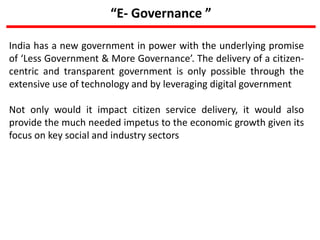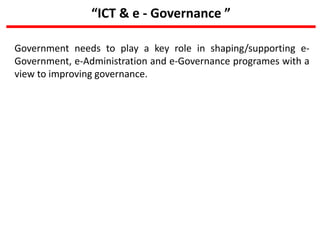Role of ICT in Good Governance
- 1. “ROLE OF ICT IN PROMOTING GOOD GOVERNANCE” Amit Kumar Scientific Assistant (Adhoc), Indira Gandhi Institute of Physical Education & Sports Sciences, B-block, Vikaspuri, Delhi
- 2. “E- Governance ” India has a new government in power with the underlying promise of ‘Less Government & More Governance’. The delivery of a citizen- centric and transparent government is only possible through the extensive use of technology and by leveraging digital government Not only would it impact citizen service delivery, it would also provide the much needed impetus to the economic growth given its focus on key social and industry sectors
- 3. “E- Governance ” Good governance is fundamental and e-governance is instrumental. Good governance dictates the design and shape of e-tools or e- governance for improving governance outcomes and processes. e- Governance can be an effective and efficient tool for good governance if and only if the process reforms have been carried out. With process re-engineeering, effective implementation of e- Governance can take IT to the common man, helping the government to align services with the changing needs of both citizens and other
- 4. “E- Governance ” One of the principal objectives of the IT policy is the extensive use of IT within the process of governance for providing better citizen services and for enhancing efficiency, transparency and accountability of Government departments, and agencies.
- 5. “ICT & e - Governance ” The emergence of the digital economy has affected both the role and functions of public institutions. While undertaking traditional functions such as defense, law and order, justice, taxation, legislation, regulation, education, healthcare and social equity, the governments are now required to take new roles of harnessing the power of information technology and leading change
- 6. “ICT & e - Governance ”
- 7. “ICT & e - Governance ” e-Government is about leading the transformation of government to provide efficient, convenient and transparent services to citizens and businesses through the use of Information and Communication Technologies (ICT). e-Government is not about ‘e’ but about ‘government’; it is not about computers and websites, but about services to citizens and business. It is about to concerns with the transformation of government, modernization of government processes and functionsand better public service delivery mechanisms through technology. Citizens are the recipients in e-Government.
- 8. “ICT & e - Governance ”
- 9. “ICT & e - Governance ” The purpose of implementing e-Governance is to improve governance processes and outcomes with a view to improving the delivery of public services to citizens. For Example e-SLA
- 10. “ICT & e - Governance ”
- 11. “ICT & e - Governance ” The United Nations distinguishes between the following areas where governmental operations can be improved by the application of ICT: e-Government: This applies to inter-organizational relationships, and includes policy coordination, policy implementation and public service delivery. e-Administration: This applies to intra-organizational relationships, and includes policy development, organizational activities and knowledge management. e-Governance: This applies to interaction between citizens, government organizations, public and elected officials, and includes democratic processes, open government and transparent decision- making.
- 12. “ICT & e - Governance ” Government needs to play a key role in shaping/supporting e- Government, e-Administration and e-Governance programes with a view to improving governance.
- 13. “ICT & e - Governance ” The application of ICT to government processes e-Governance - can have a profound impact on the efficiency, responsiveness and accountability of the government, thereby, on the quality of life and productivity of citizens, especially the poor; and ultimately, on the economic output and growth of the country as a whole. Electronic governance goes far beyond mere computerization of stand alone back office operations. It is a means to fundamentally change how the government operates and this implies a new set of responsibilities for the machinery of the government.
- 14. “ICT & e - Governance ” ICT can act as a catalyst for organizational transformation and change in government by influencing governance in several ways as follows: •Managing large volumes of data and work flow connectivity between government operations, departments and agencies and significantly reducing errors; •Reaping scale economies and improving efficiency by automation of complicated and repetitive governance tasks and developing standard applications; •Reducing personal interface of citizens and business with public service providers, cutting delay, bureaucratic red tape, corruption and harassment and increasing speed of response; and •Enhancing transparency and accountability by making information available to citizens through websites, reducing information monopoly, simplifying processes and empowering citizens to put pressure on public officials to deliver performance
- 15. “ICT & e - Governance ” National e-Governance Action Plan (NeGAP) The recently formulated National e-Governance Action Plan of India attempts to address many of the key issues of e-Governance in India with a view to harnessing the power of ICT to improve governance f or the common citizen. The structure of NeGP (2003-07) encompasses a set of core policies to provide integration and support, a set of integrated projects or cross-cutting initiatives, a set of Mission Mode Projects at national and state levels.
- 16. “ICT & e - Governance ” The Information and Communication Technologies (ICT) are being increasingly used by the governments to deliver its services at the locations convenient to the citizens. The rural ICT applications attempt to offer the services of central agencies (like district administration, cooperative union, and state and central government departments) to the citizens at their village door steps. These applications utilize the ICT in offering improved and affordable connectivity and processing solutions. Several Government-Citizen (G-C) e-Government pilot projects have attempted to adopt these technologies to improve the reach, enhance the base, minimize the processing costs, increase transparency, and reduce the cycle times
- 17. “ICT & e - Governance ” some of these projects and the experiences on developing proof-of- concept projects are: i. Design of citizen-centric services and dependable service delivery mechanisms. ii. Selection of appropriate (dependable, maintainable and cost effective) technologies for rural connectivity and information processing solutions. iii. Design of cost-effective delivery stations (kiosks) to enable private entrepreneurs operate the services profitably and build new services for sustainability iv. Ensuring employee participation with well designed change management processes
- 18. “ICT & e - Governance ” v. Demonstration of transparency and efficiency to remove distrust and build confidence among the citizens on the functioning of service delivery mechanisms. vi. Inviting private participation to reduce the burden on the central servicing agency, bring in the expertise, enhance the speed of implementation, and offer better value proposition to the citizens. vii. Identifying and preparing project champions, ensuring appropriate tenures, facilitating smooth transition, and internalization of the changed procedures.
- 19. “ICT & e - Governance ” We at our institute use whole lot of facet of e-Governance right from online admission to check thesis through plagrism. Although bio-metric is not new to us neither this technology is for India but using it efficiently for personnel management is certainly add new dimension to this technology. This technology was firstly introduced by our Institute in Delhi E-library has its own advantage of access in real time without hassle and without paper and certainly our institution is using it up to its apex. It is not only saving precious man-hour but lot of other tedious process of issuing, collecting and maintaining books. Online tendering ensure transparency besides that it expedite the process of procurement and other project. It shows our zero- tolerance towards any kind of corrupt practices.
- 20. “ICT & e - Governance ” As we know every technology is value neutral, it depends upon person or institution how to use it, further it will be not gainsaying that we use this technology for betterment of our institution, for teaching & non-teaching personnel and transcending all is our students
- 21. “ICT & e - Governance ” Certainly that day is not beyond our sight when through this e- governance every process up to last details will be hassle free, paper free, corruption free, subjectivity free and as we know for every man there is post and for every post there is a man so let be fittest man the post & work.
- 22. “ICT & e - Governance ” Three attribute for making a Strong Good & Effective e-Governance Right person on the right position. Strong Law. Technology.
- 23. Seminar on Use of Technology and Innovation in Promoting Good Governance And a Competition on Oratory (Bhaashan Shailee) on (Friday) 19th December, 2014 Indira Gandhi Institute of Physical Education & Sports Sciences, University of Delhi Good Governance Day To celebrate the Birth anniversary of Sh. ATAL BIHARI VAJPAYEE Former prime minister of India






















